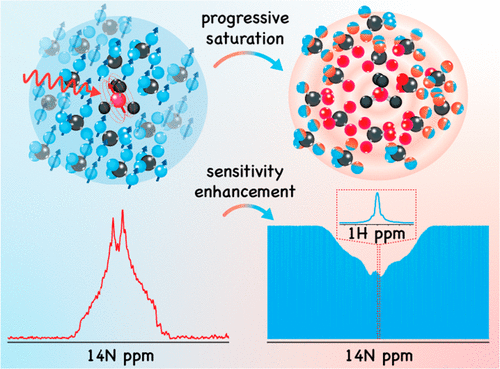当前位置:
X-MOL 学术
›
J. Am. Chem. Soc.
›
论文详情
Our official English website, www.x-mol.net, welcomes your feedback! (Note: you will need to create a separate account there.)
Sensitivity Enhancement by Progressive Saturation of the Proton Reservoir: A Solid-State NMR Analogue of Chemical Exchange Saturation Transfer
Journal of the American Chemical Society ( IF 15.0 ) Pub Date : 2021-11-18 , DOI: 10.1021/jacs.1c08277 Michael J Jaroszewicz 1 , Adam R Altenhof 2, 3 , Robert W Schurko 2, 3 , Lucio Frydman 1, 3
Journal of the American Chemical Society ( IF 15.0 ) Pub Date : 2021-11-18 , DOI: 10.1021/jacs.1c08277 Michael J Jaroszewicz 1 , Adam R Altenhof 2, 3 , Robert W Schurko 2, 3 , Lucio Frydman 1, 3
Affiliation

|
Chemical exchange saturation transfer (CEST) enhances solution-state NMR signals of labile and otherwise invisible chemical sites, by indirectly detecting their signatures as a highly magnified saturation of an abundant resonance─for instance, the 1H resonance of water. Stimulated by this sensitivity magnification, this study presents PROgressive Saturation of the Proton Reservoir (PROSPR), a method for enhancing the NMR sensitivity of dilute heteronuclei in static solids. PROSPR aims at using these heteronuclei to progressively deplete the abundant 1H polarization found in most organic and several inorganic solids, and implements this 1H signal depletion in a manner that reflects the spectral intensities of the heteronuclei as a function of their chemical shifts or quadrupolar offsets. To achieve this, PROSPR uses a looped cross-polarization scheme that repeatedly depletes 1H–1H local dipolar order and then relays this saturation throughout the full 1H reservoir via spin-diffusion processes that act as analogues of chemical exchanges in the CEST experiment. Repeating this cross-polarization/spin-diffusion procedure multiple times results in an effective magnification of each heteronucleus’s response that, when repeated in a frequency-stepped fashion, indirectly maps their NMR spectrum as sizable attenuations of the abundant 1H NMR signal. Experimental PROSPR examples demonstrate that, in this fashion, faithful wideline NMR spectra can be obtained. These 1H-detected heteronuclear NMR spectra can have their sensitivity enhanced by orders of magnitude in comparison to optimized direct-detect experiments targeting unreceptive nuclei at low natural abundance, using modest hardware requirements and conventional NMR equipment at room temperature.
中文翻译:

通过质子储层的渐进饱和提高灵敏度:化学交换饱和转移的固态 NMR 模拟
化学交换饱和转移 (CEST) 增强了不稳定和其他不可见化学位点的溶液状态 NMR 信号,通过间接检测它们的特征作为丰富共振的高度放大饱和度——例如,水的1 H 共振。在这种灵敏度放大的刺激下,本研究提出了质子储层的渐进饱和 (PROSPR),这是一种提高静态固体中稀异核的 NMR 灵敏度的方法。PROSPR 旨在使用这些异核逐渐耗尽在大多数有机和几种无机固体中发现的丰富的 1 H 极化,并实现这一H 信号耗尽的方式反映了异核的光谱强度作为其化学位移或四极偏移的函数。为了实现这一点,PROSPR 使用循环交叉极化方案,重复耗尽1 H - 1 H 局部偶极顺序,然后通过在 CEST 实验中充当化学交换类似物的自旋扩散过程在整个1 H 储层中传递这种饱和度. 多次重复这种交叉极化/自旋扩散过程会导致每个异核响应的有效放大,当以频率步进方式重复时,将它们的 NMR 光谱间接映射为丰富的1的相当大的衰减H 核磁共振信号。实验 PROSPR 示例表明,以这种方式,可以获得忠实的宽线 NMR 光谱。与在低自然丰度下使用适度的硬件要求和常规 NMR 设备进行优化的直接检测实验相比,这些1 H 检测的异核 NMR 光谱的灵敏度可以提高几个数量级。
更新日期:2021-12-01
中文翻译:

通过质子储层的渐进饱和提高灵敏度:化学交换饱和转移的固态 NMR 模拟
化学交换饱和转移 (CEST) 增强了不稳定和其他不可见化学位点的溶液状态 NMR 信号,通过间接检测它们的特征作为丰富共振的高度放大饱和度——例如,水的1 H 共振。在这种灵敏度放大的刺激下,本研究提出了质子储层的渐进饱和 (PROSPR),这是一种提高静态固体中稀异核的 NMR 灵敏度的方法。PROSPR 旨在使用这些异核逐渐耗尽在大多数有机和几种无机固体中发现的丰富的 1 H 极化,并实现这一H 信号耗尽的方式反映了异核的光谱强度作为其化学位移或四极偏移的函数。为了实现这一点,PROSPR 使用循环交叉极化方案,重复耗尽1 H - 1 H 局部偶极顺序,然后通过在 CEST 实验中充当化学交换类似物的自旋扩散过程在整个1 H 储层中传递这种饱和度. 多次重复这种交叉极化/自旋扩散过程会导致每个异核响应的有效放大,当以频率步进方式重复时,将它们的 NMR 光谱间接映射为丰富的1的相当大的衰减H 核磁共振信号。实验 PROSPR 示例表明,以这种方式,可以获得忠实的宽线 NMR 光谱。与在低自然丰度下使用适度的硬件要求和常规 NMR 设备进行优化的直接检测实验相比,这些1 H 检测的异核 NMR 光谱的灵敏度可以提高几个数量级。


























 京公网安备 11010802027423号
京公网安备 11010802027423号